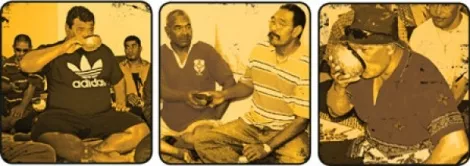
From the outside, the house in Salt Lake City’s west-side Glendale neighborhood looks like any other. It is a hot summer evening, and the front door is propped wide open. Inside, some 40 men sit cross-legged on small stools, facing east. The living room is cleared of furniture, and in the adjoining dining room, woven tapestry mats called falas cover the floors.
The white walls are sparsely decorated with a few photos of men in the group wearing matching shirts. The Tongan national crest hangs prominently on the front wall.
A house, yes, but not a home. No one actually lives here, but people can be found here just about any hour of the day or night, just about any day of the week.
This is a place where men of Pacific Islander descent gather to drink kava—an ancient and mildly psychoactive beverage that is central to celebrating social and cultural rituals. Some of the men here this night are in their 20s, but most are middle-age. Still others have full heads of gray hair. Most wear shorts and T-shirts, and their feet are bare after removing their sandals or flip-flops. The room hums softly with the sound of conversation in their native Tongan tongue.
This is a place for laughter and enjoyment, but being out of control is strictly forbidden. There is small talk and joking. The men move freely into more serious topics then back again to the lighter side. Recounting tales of days back on the island is a must.
This is a glimpse of fai’kava, a term which roughly translates as “to do kava.” The friends will sit together in this house, and fai’kava for at least a couple of hours—often all night long.
The drink itself isn’t much to look at. A light-brown liquid, kava is a combination of water and the pulverized root of a plant native to the Polynesian islands. It has the unique ability to create an overall feeling of relaxation in the body without altering clarity of the mind. Men have said that drinking kava soothes the body while keeping the mind sharp.
Every 10 or 15 minutes, two men sitting in a corner begin strumming acoustic guitars and singing in Tongan. Others soon join in. The lyrics are of love, loss, pain, good times, bad times, old memories. A song about a long-past civil war that ended with Tonga being united under one king gets most of the room singing along.
Kava has traditionally been key to Polynesian ceremonies or momentous life events, whether they involve Tongan royalty, Samoan chiefs, weddings or funerals. But views on the drink and its purpose are shifting as more Polynesians absorb American lifestyles and attitudes toward leisure.
Some Salt Lake City Pacific Islanders feel that keeping the kava culture going means keeping an essential part of their homeland alive here in America. Others say kava should only be used on ceremonial occasions. Still others feel that any use of kava violates the rules of their religion. All three views seem to peacefully co-exist within Utah’s Polynesian cultures, where one can always expect support—regardless of how one views or uses kava. Stronger than any feelings about the drink is a bedrock emphasis on extended family relations and helping one another.
Periodically someone tosses a folded bill—$20, $50, even $100—to a man in the middle of the room who keeps the cash laid out in front of him on a small wooden board. He unfolds and holds up the bill, then offers a short speech of gratitude for the donation. Cries of Malo’! ripple through the room. An LDS ward bishop happens to be visiting from Tonga tonight and the donations, which can easily surpass $1,000, will go back with him to the island to help buy a bus for transporting children from a small village to a school.
Recreation and Religion
The focal point of the kava club sits front and center in the room. The kumete is a large, carved wooden bowl about three feet across, filled with a liquid that looks, smells and tastes like little more than muddy water. The only female in attendance, an unmarried woman called a tou’a, sits in front of the kumete and, while stirring, ladles the kava into coconut-shell cups. The men then pass the cups, hand-to-hand, throughout the room.
For these men, this night out is as natural to their island culture as a typical night for American-born men at the American Legion Post or quaffing beers while watching Monday Night Football. The kava club is a social event that, like so many other customs rooted in other cultures, is evolving as Polynesians assimilate into American society.
Factoring into attitudes about kava consumption is the LDS Church. According to church’s statistics, Tonga has the highest percentage of LDS population of any nation on earth. The Mormon Church claims over 53,000 members on an island where the total population is around 116,000. Samoa ranks a close second, with 65,000 LDS members on an island with a population of slightly less than 200,000.
Given the number of immigrants in relation to their country of origin, what happens in Utah is not without effect back in the islands. For example, close to 7,000 Tongans call Utah home—a significant number, given the total population on the island.